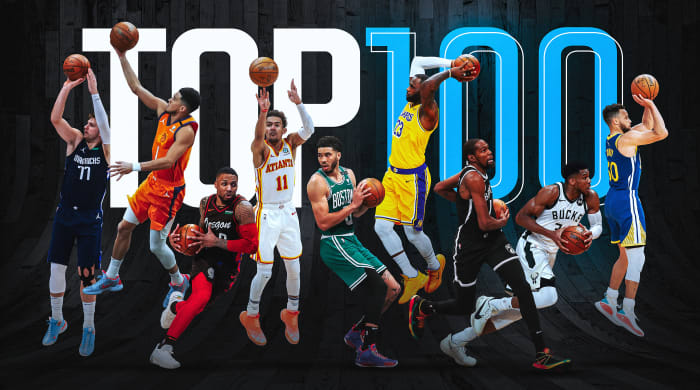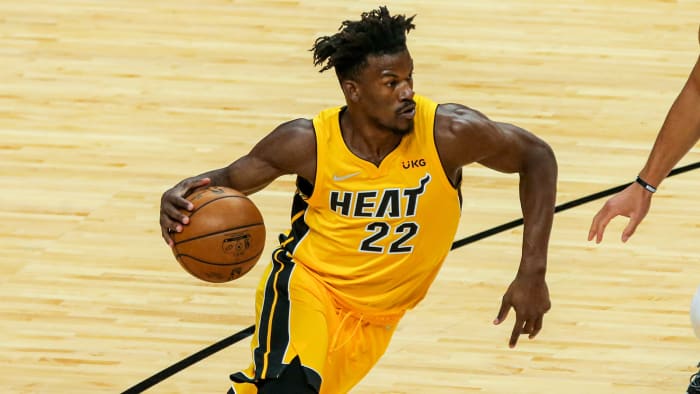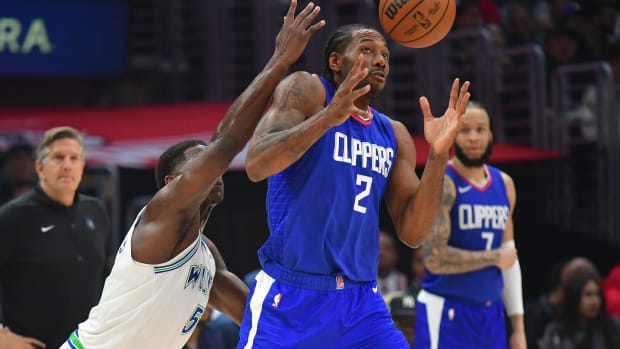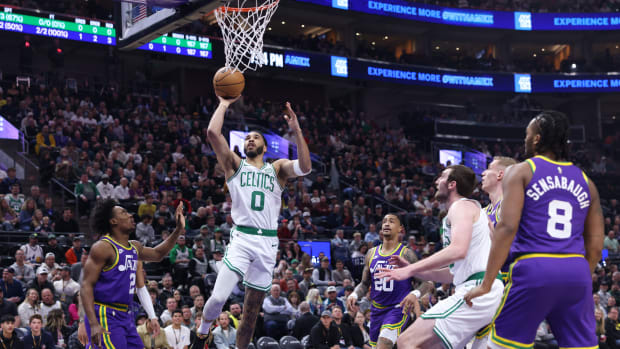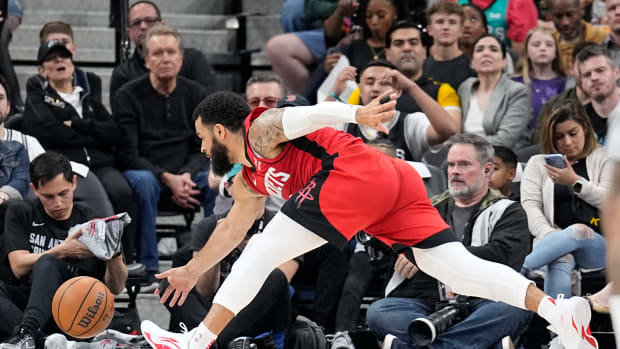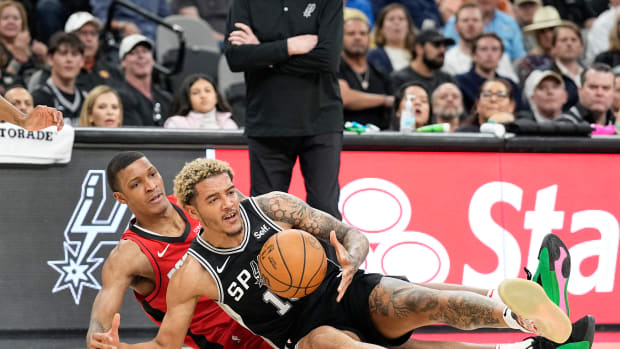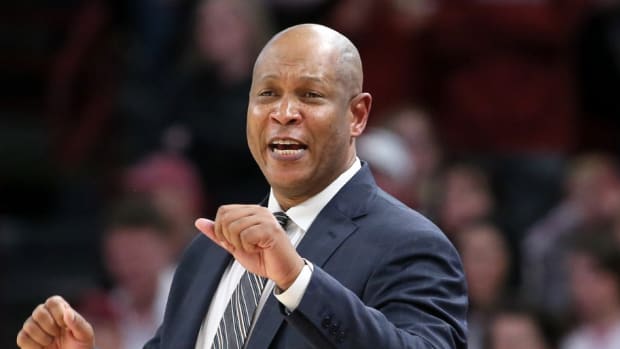Top 100 NBA Players of 2022: Which Stars Didn't Make the Top 10?
Who will be the NBA’s best players in the 2021–22 season? Sports Illustrated‘s annual Top 100 list is back, aiming to answer that question.
This year, the rankings were determined holistically by a panel of NBA writers—Chris Herring, Rohan Nadkarni, Michael Pina and Jeremy Woo—through a combination of data and subjective evaluation. (As far as the content of those discussions is concerned, consider the first rule of Fight Club.) The goal remains to evaluate players in a vacuum as much as possible, without overvaluing team context in taking stock of their quality.
To be clear, these rankings are specifically for the upcoming season and do not take into account players’ long-term prospects or career arcs beyond 2021-22. As has been the tradition here, rookies were not considered. So it’s best to consider these rankings as short-term value projections. This is not a representation of a player’s trade value or contract value, and it does not account for the impact of his salary relative to his production. The possibility of growth or decline are factors, tied to players’ age and career stage. The list attempts to account for the entirety of a player’s impact: offense, defense, structural or otherwise, and tends to favor those with the most malleable skill-sets.
Availability due to injury and the ensuing recovery process are also factors here: this year, Kawhi Leonard, Jamal Murray and Klay Thompson were most affected in that way. The biggest snubs from this year’s list can be found here.
For further reference, explore SI.com’s Top 100 lists from 2021, 2020, 2019, 2018, 2017, 2016, 2015 and 2014. SI’s Michael Shapiro, Ben Pickman and Wilton Jackson also contributed player profiles to this year's list. To listen to how the list was made: Listen to the Open Floor podcast.
SI TOP 100: Read 100-51 and 50-31
30. Shai Gilgeous-Alexander, Oklahoma City Thunder
(Previous rank: 63)
Gilgeous-Alexander played in only 35 games in 2021 but shined bright enough to be No. 30 on this list. His offensive profile would make an analytics nerd blush: Over 50% from the field, over 40% from three, and over six free-throw attempts a game. Only entering his fourth season, if SGA builds on his 2021 numbers the Thunder should seriously consider speeding up their rebuild. — RN
29. Zach LaVine, Chicago Bulls
(Previous rank: 75)
The 26-year-old All-Star, coming off a season in which he set new career-highs in virtually every statistical category, now enters a campaign he’ll be flanked by more veteran talent than he’s ever had. His counting statistics are likely to come down some. But his efficiency—already fantastic a year ago—should soar to new heights with opposing defenses stretched thinner because Chicago’s bolstered talent. — CH
28. Jrue Holiday, Milwaukee Bucks
(Previous rank: 26)
Holiday is the very best at what he does, earning widespread acclaim from his peers as the league’s top perimeter defender, with the strength and fearlessness to trail taller wings and the instincts to hang with smaller guards. Also a capable secondary playmaker who can run offense in a pinch, he shot a career-best 39.2% from three in the regular season and proved highly effective as a third option. He turned out to be the missing piece in Milwaukee’s title run. While not quite a star in the glitzy sense, Holiday remains one of the most reliable, universally effective performers in the league. — JW
27. Jaylen Brown, Boston Celtics
(Previous rank: 38)
There’s no way to know if Brown could handle the on-court responsibility typically shared by a number one option on a team that enters each season earnestly trying to win a championship. Since entering the league he’s never been one, and so long as Jayson Tatum is one of his teammates, it’s unlikely he’ll ever have to carry that type of weight. But for the purpose of this exercise, it’s not too difficult after watching the 24-year-old’s fifth and greatest season to convince yourself that he could do it, if pressed.
Brown rode one of the NBA’s most confident jump shots to his first All-Star Game last year. He also took strides as a playmaker, which is critical for a Celtics team that can’t afford his all-around ascendence to cease anytime over the next few years. — MP
26. Khris Middleton, Milwaukee Bucks
(Previous rank: 27)
If it took a Milwaukee championship for you to realize how dangerous a shot-maker Middleton has become, you weren’t watching closely enough. Working as the Bucks’s secondary option, he’s quietly been on the cusp of a vaunted 50-40-90 season for two years running, while supplying a pinch of secondary playmaking and demonstrable ability to hit big shots. His perimeter defense is merely sufficient at this point in his career. But his immaculate efficiency and bankable play can’t be undersold, particularly on a contending team. — JW
25. Ja Morant, Memphis Grizzlies
(Previous rank: 41)
Morant continues to ascend as one of the league’s genuinely breathtaking young talents, with a striking blend of speed, vertical explosion, and visionary passing that allow him to pressure defenses even without a reliable three-point shot. His 47-point performance in a playoff loss to Utah was demonstrably special. Moreover, Morant’s relentless mindset is tough to replicate. The total package here is unlike any other guard in the league, and it feels like a foregone conclusion the 22-year-old continues to improve. And if he adds a jumper, the calculus changes in a scary way. — JW
24. Donovan Mitchell, Utah Jazz
(Previous rank: 23)
There are nights when Mitchell is simply unstoppable offensively, particularly when he has his pull-up three working. The argument against placing him higher is how neatly he slots into a Jazz team that allows him to focus on offense and not his defensive shortcomings. Still, with the respect he commands from defenses, Mitchell should be in the top 25 of this list for years to come. — RN
23. Karl-Anthony Towns, Minnesota Timberwolves
(Previous rank: 18)
The past 18 months have been a living nightmare for Towns, who spent last summer getting in the best shape of his life while still grieving the death of his mother. On the court, Towns remains one of the sport’s most revolutionary figures: a wildly skilled seven-footer whose team’s offense is formidable every single year regardless of who’s around him. He can do pretty much anything on that end: pass, shoot, go off the bounce, post up, engineer pick-and-rolls, curl off screens, pop for threes, run fastbreaks...the list is endless.
Defense is where he’ll be judged until winning happens, but in a vacuum it’s worth comparing the entirety of Towns’ impact with someone like the reigning MVP Nikola Jokić. Just as a thought exercise: if they swapped teams and situations how would each be appreciated? It’s all worth considering when trying to remember how great this 25-year-old is heading into his seventh season. — MP
22. Bam Adebayo, Miami Heat
(Previous rank: 20)
No ceiling. That’s how Erik Spoelstra likes to describe Adebayo, who is arguably the most versatile and effective defensive big man in the NBA. Adebayo’s absurd defensive skills alone make him top-25 worthy. When you add in his growing offensive repertoire as both an initiator and scorer, he becomes someone that every single coach in the league covets. If Bam develops into a more confident and consistent scorer, he will take another leap up this list. — RN
21. Rudy Gobert, Utah Jazz
(Previous rank: 16)
Gobert remains the only player in the NBA capable of anchoring a playoff-caliber defense no matter who else is on the floor alongside him. His greatness as a rim protector and space-eater is why Utah’s scheme works. As we’ve seen, this value conversation is more difficult in the postseason, where Gobert’s free throw issues, lack of mobility in space, and limited offensive skills become much more glaring in a seven-game series. But there’s something to be said for the Jazz’s sustained success, and of course, his role in it. For as long as Gobert can prolong his physical prime, he’ll remain a difference-maker. — JW
20. Zion Williamson, New Orleans Pelicans
(Previous rank: 32)
If there’s one player on this list who’s powerful enough to make its compilers look foolish for an entire calendar year it’s Williamson, a wonderfully anomalous wrecking ball who proved in his second season that an ideal supporting cast isn’t necessary for him to demolish layers of NBA defense that are designed to restrict access from the aptly named restricted area. Zion thundered into it at will, attempting 13.4 shots while no other player even cracked double digits (Giannis Antetokounmpo was at 9.0). On top of that, Williamson’s initial dalliance with the point guard position was virtual reality. Problematic defense aside, if/when he’s surrounded by actual shooters it’s unclear what every other team can do, except pray. — MP
19. Kyrie Irving, Brooklyn Nets
(Previous rank: 19)
Yes, his availability is often a question. And yes, he’s generally going to be his team’s third option. But it’s not often you see a 50/40/90 season from a scorer who also has Michelangelo-level skill as a ballhandler. Irving averaged 26.9 points and six assists on 50.6% shooting, 40.2% from three and 92.2% from the line. If not for his stepping on Giannis Antetokounmpo’s foot in the conference semifinals, the Nets might very well be NBA champions. And if he and one of Kevin Durant and James Harden stay healthy, Brooklyn will be expected to claim that crown this time around. — CH
18. Chris Paul, Phoenix Suns
(Previous rank: 14)
Chris Paul didn’t just revive the Suns and quarterback a Finals run at age 36: he also put together one of the most efficient seasons of his career, posting his best field goal percentage (49.9%) since 2009, shooting nearly 40% from three and a league-best 93% from the line. He’s staved off any serious physical decline thus with irrepressible acuity and competitive fire. He certainly doesn’t look ready to enter a late-career role player phase anytime soon. While younger stars, including running mate Devin Booker, have started to surpass him on our list, Paul’s all-around impact can still be every bit as massive on a given night. He is, after all, one of the best point guards ever. — JW
17. Trae Young, Atlanta Hawks
(Previous rank: 29)
Young’s leap—from No. 29 last year—is about what you’d expect for someone like the diminutive guard, who already had one of the best offensive games in the league, having ranked among the NBA’s top five in scoring and assist average in 2020. With the league cracking down on foul-seeking efforts, Young will have to pick his spots a bit more. Still, he’ll remain one of the hardest scorers for defenders to stop. — CH
16. Devin Booker, Phoenix Suns
(Previous rank: 24)
Booker’s supernova scoring talent finally coincided with winning in 2021, as he helped lead the Suns to the NBA Finals. Booker is a three-level scorer who makes up for his slightly less deadly three-point game with a killer bucket-getting prowess inside the arc. He’s adept at using his body to create space in the lane before burying you with off-balance shots. And when his pull-up is working, he can easily go for 40, as he did back-to-back times in the Finals. Individual defense will always be a slight question mark for Booker, though he did prove during Phoenix’s run to the championship round he can absolutely contribute to a great team defensive effort. Book definitely received a healthy bump on this list because of the team success he finally experienced for really the first time in his career. His next challenge will be to prove the Suns can sustain that level moving forward. —RN
15. Bradley Beal, Washington Wizards
(Previous rank: 15)
Beal is an offensive assassin who has averaged over 30 points in back-to-back seasons despite playing for a Wizards roster that is essentially daring opposing defenses to overload their coverages to slow him down. Beal entered the league as a three-point specialist and has since morphed into somebody with an avenue to score from anywhere on the floor. Beal shot 65% from the restricted area last season while also connecting on 47.4% of his midrange attempts. His three-point prowess has opened up the entire halfcourt for his offensive repertoire, and Beal can take advantage of defenses overeager to take away his outside shot. There’s a reason Beal pops up every season in trade rumors for teams trying to get over the hump as contenders: He’s a star in waiting, and the only thing holding him back from competing for a championship is his own loyalty to Washington. — RN
14. Jimmy Butler, Miami Heat
(Previous rank: 11)
Butler is a blunt force who hammers opposing defenses over the head with effectiveness. The Heat’s ornery stare makes up for his unreliable jumper by consistently fighting his way to the free-throw stripe. Butler averaged eight freebies a night in 2021 after 9.1 attempts in 2020. He’s also excelled as a playmaker since joining Miami two seasons ago. Jimmy posted a career-best 7.1 assists per game last year, and he’s become one of the best table setters in the league. Whether he is operating out of the post or the pick-and-roll, Butler is fully committed to the Heat’s egalitarian offensive system. He leverages the attention defenses give to stop him from getting to the rim to spray the ball to shooters or run handoffs with quick-moving wings.
And defensively, Butler is still one of the best on the perimeter. He’s good for two steals a game and can credibly slow down any wing in the league on any given possession. Butler is an on-ball menace who rarely freelances lest he mess up a team effort. Ultimately, though Butler’s inconsistent shot prevents him from being placed higher on the Top 100, he’s still one of the strongest two-way forces in the world. — RN
13. Jayson Tatum, Boston Celtics
(Previous rank: 17)
Tatum has spent the past couple years flaunting his scoring genius: The mesmerizing footwork that’ll make an art appraiser’s eyelashes flutter, mixed with shoulder feints, head fakes and gorgeous dribble combinations that were regularly unleashed on wing defenders.
The frustration tends to go both ways, though, meaning Tatum really needs to streamline his arsenal. (Less driver, more three wood.) The crowd-pleasing aesthetics have been established, and now it’s time he upped the efficiency with a less glamorous shot diet. That means more trips to the free-throw line and fewer unnecessarily difficult mid-range jumpers (one out of every five of Tatum’s shots last year was a pull-up two and he only made 35.1%, which was worse than Westbrook and Antetokounmpo).
If he can do all that, a bid at the scoring title and maybe even some MVP chatter won’t be far behind. — MP
Watch NBA games online all season long with fuboTV: Start with a 7-day free trial!
12. Paul George, Los Angeles Clippers
(Previous rank: 13)
After receiving major criticism for his 2020 playoff performance, Paul Geroge delivered one of the finest seasons of his career in 2021. After putting up a 23/7/5 line during the regular season, he improved to a 27/10/5 line during the playoffs, nearly leading the Clippers to the Finals without Kawhi Leonard by his side for the second half of the postseason run. George is one of the best volume three-point shooters in the league who can also run a spread pick-and roll attack and find shots for others. When Leonard went down and Ty Lue put more on George’s plate, he delivered.
In spite of the times he’s come up short, George is exactly the kind of player every team wants when the stakes are highest. He can shoot, he can get his way to the line, he can play make for others, and he’s a realistic option to defend the best offensive players in the world on the most important possessions. There are no glaring weaknesses in George’s game, only the nights when he’s not quite as great as the other No. 1 options on this list above him, the rest of whom approach one-man offense territory. George may never be the best player on a championship team. If he’s your No. 2 however, that means your team is definitely stacked. — RN
11. Damian Lillard, Portland Trail Blazers
(Previous rank: 12)
There’s a reason Lillard has become central to the league’s grating, want-away-star discourse: he’s one of a scant few backcourt players truly dominant enough to swing the league’s balance of power. His elite production has been steady; Dame Time can feel inevitable. There’s a lot of discussion about whether the Trail Blazers will ever contend, but not enough credence given to the fact Portland hasn’t missed the playoffs since 2012-13—Lillard’s rookie year. His upward trajectory has been more or less constant ever since. At this point, we know pretty much exactly what we’ll see from him, if not what he’ll decide about his future. Don’t take the deep threes and compelling moments for granted. — JW
Coming Thursday: Players 10-1
More NBA Coverage:
- SI Top 100: Counting Down 100-51
- SI Top 100: Counting Down 50-31
- SI Top 100: Biggest Snubs
- NBA Offseason Report Cards: Eastern Conference
- NBA Offseason Report Cards: Western Conference
Sports Illustrated may receive compensation for some links to products and services on this website.






























